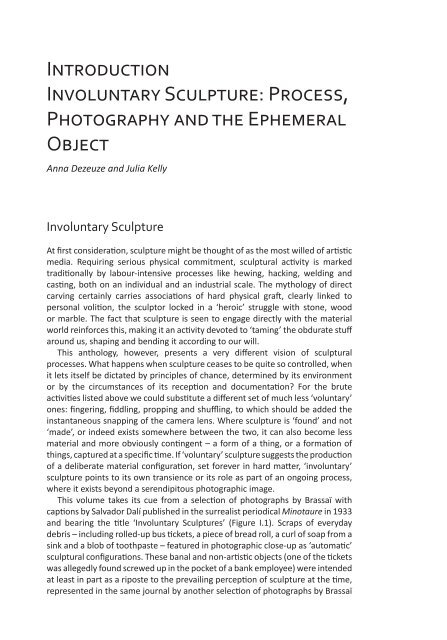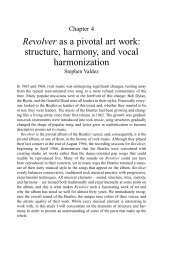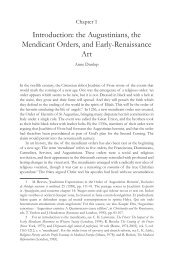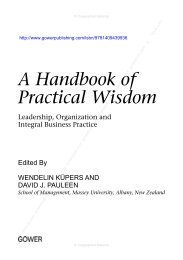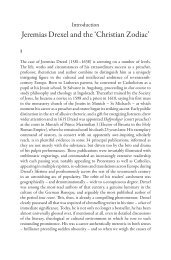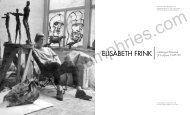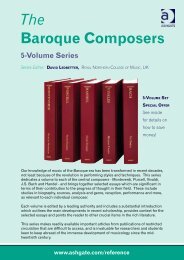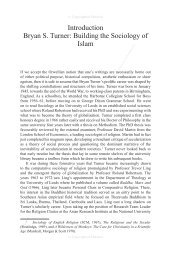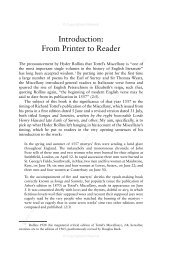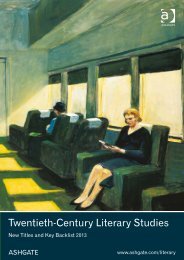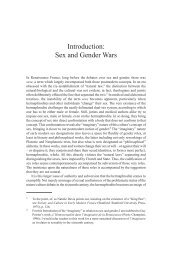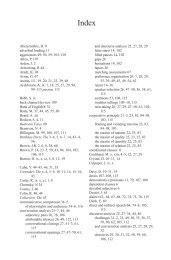Introduction Involuntary Sculpture: Process, Photography ... - Ashgate
Introduction Involuntary Sculpture: Process, Photography ... - Ashgate
Introduction Involuntary Sculpture: Process, Photography ... - Ashgate
Create successful ePaper yourself
Turn your PDF publications into a flip-book with our unique Google optimized e-Paper software.
<strong>Introduction</strong><br />
<strong>Involuntary</strong> <strong>Sculpture</strong>: <strong>Process</strong>,<br />
<strong>Photography</strong> and the Ephemeral<br />
Object<br />
Anna Dezeuze and Julia Kelly<br />
<strong>Involuntary</strong> <strong>Sculpture</strong><br />
At first consideration, sculpture might be thought of as the most willed of artistic<br />
media. Requiring serious physical commitment, sculptural activity is marked<br />
traditionally by labour-intensive processes like hewing, hacking, welding and<br />
casting, both on an individual and an industrial scale. The mythology of direct<br />
carving certainly carries associations of hard physical graft, clearly linked to<br />
personal volition, the sculptor locked in a ‘heroic’ struggle with stone, wood<br />
or marble. The fact that sculpture is seen to engage directly with the material<br />
world reinforces this, making it an activity devoted to ‘taming’ the obdurate stuff<br />
around us, shaping and bending it according to our will.<br />
This anthology, however, presents a very different vision of sculptural<br />
processes. What happens when sculpture ceases to be quite so controlled, when<br />
it lets itself be dictated by principles of chance, determined by its environment<br />
or by the circumstances of its reception and documentation? For the brute<br />
activities listed above we could substitute a different set of much less ‘voluntary’<br />
ones: fingering, fiddling, propping and shuffling, to which should be added the<br />
instantaneous snapping of the camera lens. Where sculpture is ‘found’ and not<br />
‘made’, or indeed exists somewhere between the two, it can also become less<br />
material and more obviously contingent – a form of a thing, or a formation of<br />
things, captured at a specific time. If ‘voluntary’ sculpture suggests the production<br />
of a deliberate material configuration, set forever in hard matter, ‘involuntary’<br />
sculpture points to its own transience or its role as part of an ongoing process,<br />
where it exists beyond a serendipitous photographic image.<br />
This volume takes its cue from a selection of photographs by Brassaï with<br />
captions by Salvador Dalí published in the surrealist periodical Minotaure in 1933<br />
and bearing the title ‘<strong>Involuntary</strong> <strong>Sculpture</strong>s’ (Figure I.1). Scraps of everyday<br />
debris – including rolled-up bus tickets, a piece of bread roll, a curl of soap from a<br />
sink and a blob of toothpaste – featured in photographic close-up as ‘automatic’<br />
sculptural configurations. These banal and non-artistic objects (one of the tickets<br />
was allegedly found screwed up in the pocket of a bank employee) were intended<br />
at least in part as a riposte to the prevailing perception of sculpture at the time,<br />
represented in the same journal by another selection of photographs by Brassaï
<strong>Introduction</strong> 3<br />
of the studios of Aristide Maillol, Charles Despiau, Alberto Giacometti, Jacques<br />
Lipchitz and Henri Laurens, as Steven Harris’s essay in this volume makes clear.<br />
There was no agreed definition of ‘surrealist’ sculpture, however: indeed, such<br />
a thing could be argued to be impossible in itself, while surrealist interests in<br />
three-dimensional production became much more closely oriented towards the<br />
complex category of the surrealist object.<br />
Brassaï and Dalí’s photo-essay provides a tantalising evocation of sculptural<br />
possibility, where forms are both shaped by human hands, sometimes with<br />
little conscious thought (the rolled bus ticket), and subject to ‘organic’ growth<br />
(the piece of bread rising and changing shape in the oven). It also freezes its<br />
array of objects at a given moment, before they are discarded, swept or wiped<br />
away, dissolved or eaten. Nevertheless, their photographic capturing does<br />
give them a certain solid presence, particularly through Brassaï’s characteristic<br />
use of dramatic chiaroscuro. In this sense their effect is unlike that of another<br />
surrealist image on a related theme, Man Ray’s photograph Moving <strong>Sculpture</strong><br />
for La Révolution surréaliste in 1926, a film-still-like scene of pale-coloured<br />
washing fluttering on the breeze. The title of Man Ray’s photograph, originally<br />
taken in 1920, suggests that this is a record of a particular phenomenon: the<br />
drying laundry as kinetic sculpture, its soft fabric billowing and bulging. In both<br />
images, though, the parameters of ‘sculpture’ are challenged and expanded,<br />
while photography fulfils simultaneous (and potentially contradictory) functions<br />
of auratic reproduction and quasi-scientific documentation. In her essay in this<br />
volume, Samantha Lackey argues that the film from which this image of washing<br />
was drawn, Le Retour à la raison, was a crucial example of a specific mode of<br />
cinematic distraction, where the constant progression of moving object-tableaux<br />
and fragmented scenes served to disrupt rather than focus the spectator’s<br />
attention.<br />
Rather than looking to avoid or resolve them, this volume seeks out the<br />
contradictions and pressure points inherent in the concept of ‘involuntary<br />
sculpture’, and in the relations between sculpture and photography that often<br />
accompany it. It is here, we argue, that modern and contemporary sculpture<br />
can be of continued and renewed interest, by operating against the grain of<br />
established categories and conventions.<br />
<strong>Sculpture</strong> and <strong>Photography</strong><br />
<strong>Sculpture</strong>’s relationship to photography has become a focus of scholarly interest<br />
since the late 1990s. 1 The two media at first seem to have little in common,<br />
one dealing with three-dimensional presence, the other with two-dimensional<br />
image. While the interrelation between painting and photography tended to<br />
be antagonistic in the late nineteenth and early twentieth centuries, as each<br />
competed with and fed off the advantages of the other, sculpture seemed to<br />
provide, however, particularly successful subject matter for photography from its<br />
emergence in the late 1830s. Like the still life, a sculpture did not move and thus<br />
lent itself well to long exposure, as exemplified in images of antique statuary<br />
and busts by Hippolyte Bayard and William Henry Fox Talbot in the 1840s. Such
4<br />
Found <strong>Sculpture</strong> and <strong>Photography</strong> from Surrealism to Contemporary Art<br />
images carried further symbolic resonances: sculpture’s traditional associations<br />
with death and the deathly found a parallel in the immortalising processes of<br />
the photograph, a central concern in photographic theory from the writings of<br />
Walter Benjamin to those of Roland Barthes.<br />
<strong>Sculpture</strong> also, especially in the case of antique copies and casts in white<br />
plaster, stone and marble, had exceptional photogenic qualities, setting<br />
up striking contrasts of light and shade as well as nuances of texture. In this<br />
sense, both media share a manipulation of effects of light, as well as a concern,<br />
potentially, with framing and apprehending an object from specific points of<br />
view. Through photographic representation, sculptures can take on another<br />
life, eternalised as images in their own right in what André Malraux would call<br />
the ‘museum without walls’. The ways in which Auguste Rodin’s sculpture was<br />
photographed by Eugène Druet, Edward Steichen and others around the 1900s<br />
set a particular precedent for this, while the play of light on polished surfaces and<br />
the use of photography to explore interrelationships between sculptural pieces is<br />
associated above all with the experimental photographic practice of Constantin<br />
Brancusi, as several scholars have pointed out. 2 The work of these two sculptors<br />
and its photographic representation can be said to have established certain<br />
paradigms in the relationship between sculpture and photography, extending<br />
beyond the concerns of materiality, light and volume to those of sculptural<br />
installation and the conceptualisation of the work of the sculptor him- or herself.<br />
In the interplay of sculpture and photography, the physical practices<br />
normally associated with making sculpture and the ‘mechanical’ processes<br />
of the photograph clash and challenge one another. This volume treats such<br />
tensions as generative, as ways of complicating historical distinctions and<br />
categories. Thomas McEvilley, in his analysis of the growing prominence of<br />
sculptural tendencies in art from the 1960s onwards, characterises what he sees<br />
as sculpture’s ‘ethical’ superiority as follows: ‘Painting means escapist fantasy;<br />
sculpture means direct dealing with the material world.’ 3 This volume, however,<br />
seeks to complicate such oppositions, taking its starting point from surrealism<br />
(perhaps the modern movement most readily associated with ‘escapist fantasy’),<br />
but also exploring the multiple roles of photography as both artwork in its own<br />
right and documentation, as object and image, as material evidence and the<br />
dematerialising frame for the absent, the lost, the imagined.<br />
Surrealist Object, Surrealist <strong>Photography</strong><br />
Surrealist practice in three dimensions is most commonly understood in terms<br />
of the surrealist object, whose radical hybridity and innovative engagement<br />
with everyday commodities have made it a seminal precursor for contemporary<br />
three-dimensional practices as well as installation art. The surrealist objects<br />
that have attracted the most attention are those which manifest a fetishistic<br />
concern with the body or a confusion of animate and inanimate elements, such<br />
as Meret Oppenheim’s famous Fur-covered Cup, Saucer and Spoon, or Dalí’s<br />
Lobster Telephone. Accordingly, the legacy of surrealism in later twentieth- and
<strong>Introduction</strong> 5<br />
twenty-first-century art has been seen predominantly in terms of expressions<br />
of visceral eroticism and ‘uncanny’ physicality, in the work of Louise Bourgeois,<br />
Robert Gober, Cathy de Monchaux and Sarah Lucas, amongst others. However,<br />
this emphasis has obscured the more subtle ramifications of surrealism’s<br />
concerns with objects and sculpture. The surrealist object itself presents a<br />
tension between chance encounters with and of unfamiliar things on the one<br />
hand, and the artist’s processes of intervention and control on the other. In<br />
fact, there are many types of surrealist objects, including natural objects, the<br />
Duchampian readymade, as well as found objects known through photographs<br />
(in André Breton’s 1928 novel Nadja for example), and collaborative, ephemeral<br />
constructions. While both Simon Baker and Margaret Iversen return to Breton’s<br />
use of photographs in this volume, ephemeral constructions are central to Anna<br />
Dezeuze’s and Martha Buskirk’s essays, and an interest in natural geological<br />
configurations appears to link practices as different as Giacometti’s (discussed by<br />
Julia Kelly) and Mike Kelley’s (the focus of John Welchman’s essay). In the proofs<br />
for the project, Brassaï actually refers to the <strong>Involuntary</strong> <strong>Sculpture</strong>s as ‘automatic<br />
objects’, blurring the distinctions between found object and photography,<br />
while referring to the surrealist practice of automatic writing as a means to<br />
channel unconscious thoughts. As a repository for unconscious psychic urges,<br />
the surrealist object as a whole sets in motion an interplay between artist and<br />
creator, and between object and viewer, whose encapsulation within a discrete<br />
physical thing can only be ambivalent.<br />
The crucial role of photography in surrealism has been increasingly<br />
acknowledged and studied, starting with Rosalind Krauss’s 1981 essay, in which<br />
the <strong>Involuntary</strong> <strong>Sculpture</strong>s are discussed as typical of the surrealists’ use of the<br />
camera as a privileged means of accessing the ‘surreality’ of the world, that<br />
is, its nature as representation to be probed in search of the marvellous. ‘As it<br />
signals that experience of reality the camera frame also controls it, configures it’,<br />
explains Krauss: in the <strong>Involuntary</strong> <strong>Sculpture</strong>s, it is the close-up that extends the<br />
capacity of the eye and brings into being these hitherto invisible ‘sculptures’. 4<br />
Dalí himself had pointed out as early as 1929 that ‘the mere fact of photographic<br />
transposition [of the world around us] already implies a total invention: the<br />
registering of an UNKNOWN REALITY’. 5 As Dawn Ades and Simon Baker have<br />
suggested, the very practice of the photographic close-up embodies the historical<br />
ambivalence of photography between scientific objectivity and defamiliarisation<br />
or disorientation. While the glass shelf used by Brassaï to photograph the<br />
<strong>Involuntary</strong> <strong>Sculpture</strong>s recalls the glass slides used in the microscopic preparations<br />
that were the subject of early scientific photography, 6 the enlargement of such<br />
small objects robs them of their recognisability, triggering powerful ‘alienating<br />
effects’. 7 The new modes of attention required by the cinematic close-up are<br />
extensively discussed in this book by Samantha Lackey, while Carrie Lambert-<br />
Beatty refers to their performance of a child-like view of the world.<br />
For Margaret Iversen and Simon Baker, writing in this volume, the interaction<br />
between the found object and the surrealist photograph is crucial. Where<br />
Baker sees the photograph as participating actively in the introduction of the<br />
found object into a ‘perceptual regime’ that will guarantee its significance as a<br />
meaningful find for viewers to come, Iversen goes one step further and directly
6<br />
Found <strong>Sculpture</strong> and <strong>Photography</strong> from Surrealism to Contemporary Art<br />
compares the operation of the found object to that of photography itself. The<br />
‘involuntary’ nature of photography, she argues, exists at the moment in which<br />
a detail in the most banal photograph – what Barthes has called the ‘punctum’ –<br />
can unexpectedly reach out directly to the viewer’s unconscious, just as an object<br />
can be found to answer its finder’s most intimate desires and fears. In theories<br />
of photography, this ‘involuntary’ account counters the simulacral model of the<br />
photograph as a blank, free-floating, empty signifier. In artistic practices, Iversen<br />
demonstrates how Christian Boltanski and Gabriel Orozco bring together the<br />
found object and the photograph in order to complicate the relations between<br />
reality and simulation. In this way, Iversen is returning us to what Robin Kelsey<br />
and Blake Stimson have described as the original ‘dream of photography’ – a<br />
desire to reconcile the extremes of a ‘seemingly unconditional transcriptive<br />
fidelity’ and ‘seemingly unconditional inner revelation’. 8<br />
<strong>Process</strong> and ‘Dematerialisation’<br />
Elusive desires and intimations of death are captured in the web of relations<br />
between surrealist objects, photography and autobiographical narratives.<br />
Along with other surrealist techniques such as automatic writing or the practice<br />
of the exquisite corpse, this type of process is what constitutes, according to<br />
Simon Baker, one of the most important legacies of surrealism in contemporary<br />
art. If Baker refers to the specific contemporary practice of Melissa McGill, in<br />
which the creation of physical sculptures is mediated through photography, the<br />
notion of process became a particularly significant characteristic of sculpture<br />
and conceptual art in the 1960s and 1970s. In fact, the ‘process art’ of Richard<br />
Serra involves, as Anna Dezeuze points out, the very gestures of tearing, spilling<br />
or rolling involved in the creation of the <strong>Involuntary</strong> <strong>Sculpture</strong>s. Other, more<br />
everyday processes were evoked in Terry Fox’s Children’s Tapes (discussed by<br />
Carrie Lambert-Beatty in this volume), in which the artist recorded simple physics<br />
experiments using humble household objects in his kitchen.<br />
Other conceptual artists interested in process turned to spaces outside the<br />
studio and the gallery in their desire to engage with natural landscapes or the<br />
urban everyday. In all these forms, photography and video became essential<br />
tools for documenting process, whether ephemeral constructions in the studio<br />
or site-specific interventions in the landscape. Douglas Fogle has celebrated<br />
the <strong>Involuntary</strong> <strong>Sculpture</strong>s as forerunners of conceptual photography, which is<br />
used as a means to an end rather than an end in itself, thus evading the two<br />
dominant categories in the history of photography: ‘photographic Pictorialism’<br />
and documentary photography. 9 An ‘extraphotographic impulse’ which disrupts<br />
modernist notions of photography does indeed characterise a certain type of<br />
surrealist photography as well as conceptual practices such as Terry Fox’s or<br />
Mike Kelley’s, along with those of Robert Smithson and Dan Graham. As Dezeuze<br />
suggests, Richard Wentworth’s series of photographs Making Do, Getting By,<br />
started in the 1970s, is indebted to this kind of understanding of conceptual<br />
photography as a tool to document other overarching concerns – in his case, the<br />
‘sculptures’ that we spontaneously create in everyday situations.
<strong>Introduction</strong> 7<br />
The emphasis on process naturally led artists away from the production of<br />
objects and sculptures and towards a combination of photographic and textual<br />
documentation which Lucy Lippard described as a ‘dematerialisation of the art<br />
object’ in 1968. ‘Dematerialised’ practices involved a general ‘de-emphasis’ of the<br />
‘material aspects’ traditionally associated with artworks, including ‘uniqueness,<br />
permanence, decorative attractiveness’. 10 The <strong>Involuntary</strong> <strong>Sculpture</strong>s bring<br />
together two forms of ‘dematerialisation’: the emphasis on the ephemeral, and<br />
the use of photography as a record of these impermanent objects. In this sense,<br />
they also relate to a variety of ‘dematerialising’ practices at different historical<br />
moments. As Martha Buskirk’s essay shows, ‘proto-conceptual’ artists such<br />
as Allan Kaprow developed photography alongside ephemeral environments<br />
using junk materials. Though aware of their intrinsic connection, Kaprow<br />
never privileged photography over the material creation of the environments,<br />
unlike the conceptual artists who would follow him. Kaprow’s work embodies<br />
a transitional moment before photography established itself as the language<br />
of dematerialisation. Some 20 years later, Mike Kelley returned to Kaprow’s<br />
suspicion of the documentary function of performance photographs, but set<br />
out to explore the very relations between reality and fantasy through the use<br />
of found and accidental photographs, sometimes in parallel, and sometimes in<br />
dialogue, with his performance and installation practice. Kaprow’s and Kelley’s<br />
practices thus appear to bracket a seminal moment of conceptual photography<br />
in the 1960s and 1970s, in which the model was the figure of the amateur<br />
photographer, and the medium was considered to be untainted, so to speak, by<br />
the history of art, thus facilitating a more direct access to reality.<br />
This turn to new fields of everyday life was not so much a dematerialisation,<br />
as an ‘expansion or diminution of art as a solid structure’, as Lawrence Alloway<br />
suggested in 1969, as the ‘interface’ between art and other fields became<br />
‘blurred’. 11 Whether interpreted in an ‘expansionist’ or a ‘reductivist’ model, to<br />
use Alloway’s words, this shift served to radically challenge the fetishisation of<br />
the art object – after all, as William Pietz has explained, the fetish is premised<br />
on a ‘irreducible, untranscended materiality’. 12 Rather than negating materiality<br />
in itself, then, the cross-overs between process art and conceptual photography<br />
discussed in this volume recast the materiality of both the fetish and objectbased<br />
sculpture, traditionally defined as stable, if not monumental. In this sense,<br />
the precarious balancing acts involved in Fox’s Children’s Tapes, in Wentworth’s<br />
Making Do, Getting By series (Figures 5.1 and 5.2) or in Orozco’s more recent<br />
ephemeral arrangements, all serve to dramatise a materiality that is both literally<br />
and ontologically contingent.<br />
Re-Reading the History of <strong>Sculpture</strong><br />
Where Douglas Fogle’s study of photoconceptualism outlined a new trajectory<br />
of conceptual art within the medium of photography, Helen Molesworth’s 2005<br />
exhibition, Part Object Part <strong>Sculpture</strong>, sought to retrieve a ‘space of fantasy and<br />
desire’ within the production of sculpture and painting from the 1950s to the<br />
present, through erotic logics of repetition and displacement. 13 The present
8<br />
Found <strong>Sculpture</strong> and <strong>Photography</strong> from Surrealism to Contemporary Art<br />
book can be situated in an intermediate space between these two projects. We<br />
certainly share with Molesworth a desire to displace the dominance of minimalism<br />
in ‘accounts of the scope and aim of late twentieth-century sculpture’, and its<br />
attendant privileging of both Duchamp’s readymades as foundational models and<br />
the emphasis on a ‘logic of industrial production’ (prevalent in minimalism and<br />
pop art). While we also believe that reflection on bodily gestures and unconscious<br />
desires can fruitfully be brought forward to counter these pervasive narratives,<br />
the kind of works discussed in the present book do not evoke seductive or<br />
repulsive body parts, sexual organs or skin in the same direct way as the sculptural<br />
works of Louise Bourgeois, Eva Hesse, Yayoi Kusama, Lynda Benglis or Alberto<br />
Burri. Tactility does figure prominently in Julia Kelly’s essay, for example, but it is<br />
mediated by forms evoking archaic implements or imaginary inventions as much<br />
as bodily shapes. The <strong>Involuntary</strong> <strong>Sculpture</strong>s may share the ghostly presence of<br />
absent bodies with Rachel Whiteread’s casts, but they are much less physical<br />
and ‘resistant to words’ (as Molesworth would put it): the mediation of Brassaï’s<br />
photography has the effect, as we have suggested, of introducing other types of<br />
polarity between matter and the immaterial, between singular ephemeral event<br />
and banal repetition, between form and formlessness. 14 That Gabriel Orozco’s<br />
practice figures as a paradigmatic project in both this book and Molesworth’s<br />
show suggests how the two fields can be combined productively. Inspired by<br />
Orozco’s ‘work tables’ scattered with objects, Briony Fer’s discussion of ‘sculpture<br />
as leftover’ in Part Object Part <strong>Sculpture</strong> could usefully be brought to bear on<br />
the <strong>Involuntary</strong> <strong>Sculpture</strong>s themselves. 15 Particularly suggestive is Fer’s analysis of<br />
leftovers as ‘part objects in time rather than space’, thus highlighting a fractured,<br />
discontinuous time. Her opposition between the ‘economy of leftovers’ and the<br />
‘economy of collecting’, in the sense that the latter is a means of controlling a kind<br />
of ‘dispersion’ that the former encourages, is also very fruitful. 16<br />
In Part Object Part <strong>Sculpture</strong>, it is Duchamp’s 1950s cast objects that provide<br />
an alternative trajectory to his mass-produced readymades; in Fogle’s The<br />
Last Picture Show the main reference is Dust Breeding, the photograph taken<br />
by Man Ray of the dust gathered on Duchamp’s Large Glass, a ‘hybrid object<br />
caught somewhere between the realms of photography and sculpture’. 17 This<br />
book explores the field of the surrealist object as it emerges at the intersection<br />
of these different approaches to matter and process. Perhaps the connecting<br />
link within the Duchampian field is the ‘infra-mince’ – this notion, developed by<br />
Duchamp in his notes, seems to oscillate itself between matter and immaterial,<br />
bodily presence and absence. The infra-mince can be found in the difference<br />
between two casts from the same mould as much as in the ‘heat of a seat (that<br />
has just been left)’; the folds in a pair of trousers are, according to Duchamp,<br />
‘a sculptural expression of the person who has worn them’, in much the same<br />
way, we may add, as the curled bus ticket found in his or her pocket … . 18 The<br />
more political dimensions of such infra-mince phenomena become clearer if<br />
we follow Benjamin Buchloh’s suggestion that the ‘desire to demarcate one’s<br />
somatic existence in space’ animating the <strong>Involuntary</strong> <strong>Sculpture</strong>s can be linked<br />
(in Orozco’s work for example) to an exploration of ‘the collective dormant<br />
symbolic resistance against the total reification, if not the extinction, of subject/<br />
object relationships’. 19
<strong>Introduction</strong> 9<br />
Agency and Memory<br />
Subject/object relations certainly lie at the heart of this volume, in which André<br />
Breton’s concern with the ‘objectification of the subjective’ runs like a thread.<br />
The <strong>Involuntary</strong> <strong>Sculpture</strong>s ‘inhabit a space at once real and phantasmatic’,<br />
concludes Iversen; they ‘act as attentional bridges between the everyday and the<br />
fantasmatic’ according to Lambert-Beatty. As the aura of objects is challenged –<br />
through an appeal to touch, as Harris and Kelly demonstrate, and through the<br />
mediation of photography, as Iversen and Baker suggest – the very definition of<br />
subjectivity is questioned.<br />
In a late essay, Brassaï would argue that the photograph developed in the<br />
darkroom acted as a metaphor for Marcel Proust’s well-known accounts of<br />
‘involuntary memory’, a latent remembrance suddenly triggered by an everyday<br />
object or experience, such as the taste of a madeleine dipped in tea. In that kind<br />
of moment, past and present locations are telescoped, and, according to Proust,<br />
‘our whole person … totters between them … in the vertigo of an uncertainty like<br />
the kind we sometimes experience before an ineffable vision, at the moment<br />
of falling asleep’ 20 – a state of demi-sommeil that Samantha Lackey relates to<br />
experimental film techniques in this volume. This vertigo can be heightened<br />
not only by alternating states of attention and distraction in film, but also by<br />
the very slippery relation between photography and reality in which, as Buskirk<br />
and Iversen point out, the photograph can shape, and even corrupt, our very<br />
memory of an ephemeral object.<br />
Memory involves collective as well as individual forms of agency. Dezeuze<br />
relates it to biological instincts and everyday practices, while Kelly and Harris<br />
invoke archaic encounters with nature. Welchman focuses on the vast collective<br />
unconscious that Mike Kelley mines through his explorations of American popular<br />
culture. In this sense, the ‘involuntary’ is identified with the ‘anonymous’ or the<br />
‘impersonal’, as Paul Eluard would in his 1942 book of Poésie involontaire et<br />
poésie intentionnelle, a collection that includes, alongside extracts from writers<br />
such as Francis Ponge or Raymond Queneau, a selection of children’s tales and<br />
questions, as well as found items including names of flowers, a description<br />
from a magician’s catalogue, and a bizarre news item. 21 Just as Eluard sought<br />
to demonstrate that poetry has never been the property of poets alone, the<br />
<strong>Involuntary</strong> <strong>Sculpture</strong>s raise crucial issues of authorship and agency, and the<br />
broader question of how exactly such individual and collective unconscious<br />
desires can be embodied in objects and photographs. Whether approaching<br />
them through anthropology or psychoanalysis, through educational theories or<br />
studies of everyday life, the essays in this book probe these complex questions.<br />
Rather than providing a final and unified answer, what we hope to demonstrate<br />
is that the ramifications of the <strong>Involuntary</strong> <strong>Sculpture</strong>s can extend from the<br />
beginnings of sculpture to contemporary practices, and into fields outside the<br />
history of art itself – a true testimony to the lasting impact of surrealism.
10<br />
Found <strong>Sculpture</strong> and <strong>Photography</strong> from Surrealism to Contemporary Art<br />
Notes<br />
1 Instances of this include Michel Frizot and Dominique Païni (eds), Sculpter<br />
Photographier/Photographie <strong>Sculpture</strong> (Paris, 1993), Erika Billeter (ed.), Skulptur im<br />
Licht der Fotografie (Duisburg, 1997) and Geraldine Johnson (ed.), <strong>Sculpture</strong> and<br />
<strong>Photography</strong>: Envisioning the Third Dimension (Cambridge, 1998).<br />
2 See for example Hélène Pinet, ‘La <strong>Sculpture</strong>, la photographie et le critique’, Jacques<br />
Leenhardt, ‘Au-delà de la matière: Brancusi et la photographie’, and Elizabeth A.<br />
Brown, ‘L’atelier métaphorique’, in Frizot and Païni (eds), Sculpter Photographier,<br />
pp. 85–91, pp. 33–9 and pp. 41–55; Paul Paret, ‘<strong>Sculpture</strong> and its Negative: The<br />
Photographs of Constantin Brancusi’, and Hélène Pinet, ‘Montrer est la question<br />
vitale: Rodin and <strong>Photography</strong>’, in Johnson (ed.), <strong>Sculpture</strong> and <strong>Photography</strong>,<br />
pp. 101–30 and 68–85.<br />
3 Thomas McEvilley, <strong>Sculpture</strong> in the Age of Doubt (New York, 1999), p. 42.<br />
4 Rosalind Krauss, ‘The Photographic Conditions of Surrealism’, October 19 (Winter<br />
1981), p. 31.<br />
5 Salvador Dalí, ‘Photographic Data’ [1929], quoted by Simon Baker in ‘Watch Out for<br />
Life: The Conceptual Close-Up, 1920–2006’, in Dawn Ades and Simon Baker, Close-<br />
Up: Proximity and Defamiliarisation in Art, Film and <strong>Photography</strong> (Edinburgh, 2008),<br />
p. 78.<br />
6 Dawn Ades, ‘Little Things: Close-up in Photo and Film, 1839–1963’, in Ades and<br />
Baker, Close-Up, p. 48.<br />
7 Baker, ‘Watch Out for Life’, in Ades and Baker, Close-Up, p. 95.<br />
8 Robin Kelsey and Blake Stimson, ‘<strong>Photography</strong>’s Double Index (A Short History<br />
in Three Parts)’, in Kelsey and Stimson (eds), The Meaning of <strong>Photography</strong><br />
(Willliamstown, MA and New Haven, 2008), p. xvii.<br />
9 Douglas Fogle (ed.), The Last Picture Show: Artists Using <strong>Photography</strong>, 1960–82<br />
(Minneapolis, 2003).<br />
10 Lucy Lippard, ‘Preface’, in Six Years: The Dematerialization of the Art Object from<br />
1966 to 1972 (London, 1973), p. 5.<br />
11 Lawrence Alloway, ‘The Expanding and Disappearing Work of Art’, Auction, III/2<br />
(October 1969), reprinted in Alloway, Topics in American Art since 1945 (New York,<br />
1975), p. 207.<br />
12 William Pietz, ‘The Problem of the Fetish, Part I’, Res, 9 (Spring 1985), p. 6.<br />
13 Helen Molesworth, ‘<strong>Introduction</strong>: Part Object, Part <strong>Sculpture</strong>’, in H. Molesworth<br />
(ed.), Part Object Part <strong>Sculpture</strong> (Columbus, OH, 2005), p. 25.<br />
14 Ibid., p. 25.<br />
15 Briony Fer, ‘The Scatter: <strong>Sculpture</strong> as Leftover’, in Molesworth (ed.), Part Object Part<br />
<strong>Sculpture</strong>, pp. 222–33.<br />
16 Ibid., p. 231.<br />
17 Fogle, ‘The Last Picture Show’, in The Last Picture Show, p. 10.<br />
18 Marcel Duchamp, Notes (Paris, 1999), pp. 21, 34 (our translation).<br />
19 Benjamin Buchloh, ‘Gabriel Orozco: <strong>Sculpture</strong> as Recollection’, in Yve-Alain Bois (et<br />
al.), Gabriel Orozco (London, 2006), p. 178.
<strong>Introduction</strong> 11<br />
20 Brassaï, Proust in the Power of <strong>Photography</strong> [1997], trans. R. Howard (Chicago,<br />
2001), p. 137.<br />
21 Paul Eluard, Poésie involontaire et poésie intentionnelle (Paris, 1942).


